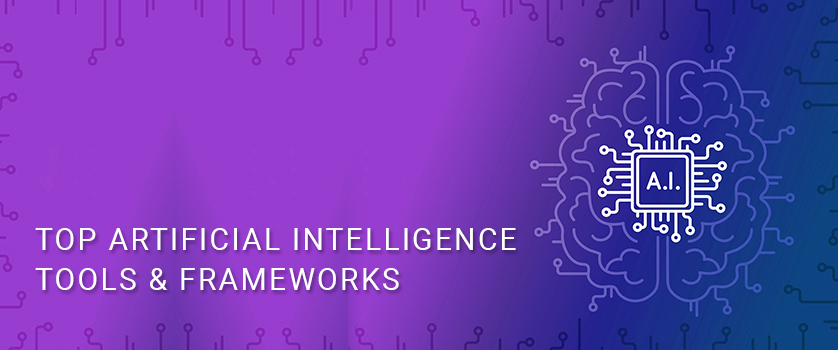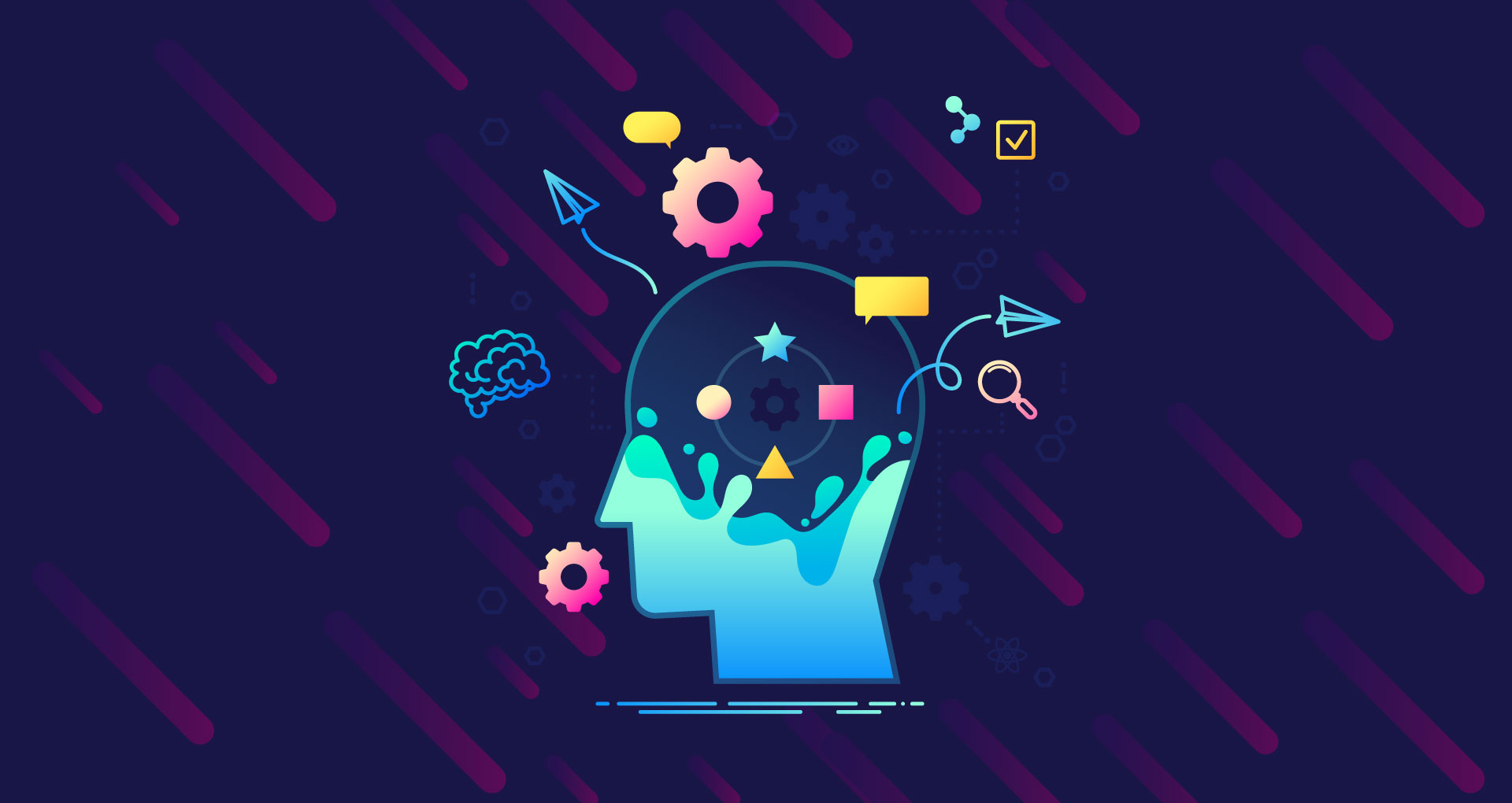
Anshul Jain
July 31, 2020
Artificial Intelligence (AI) is currently leading the world of technology and has become omnipresent. From Amazon, Netflix, Spotify, to Facebook, Twitter, Alexa, Siri, and more, all are driven by artificial intelligence and its various subfields. Today, the role of artificial intelligence is not only limited to research but has transcended into assisting organizations with the development of new and more advanced frameworks, libraries, and tools that further allow agile and accurate development of advanced and intelligent machines.
Since these tools and frameworks are needed in various fields and industries, in this article, we are going to list some of the most popular and top quality artificial intelligence tools and frameworks that are being used for the development of intelligent machines. Let's begin.
Top Artificial Intelligence Tools & Frameworks:
The rapid advancement in artificial intelligence and machine learning has resulted in an increase in the number of tools and frameworks that facilitate the development of artificial intelligence. Therefore, here are some of these and popular important AI tools and frameworks that enable AI machines to deliver high performance and quality in real-time.
- TensorFlow:
A free and opensource machine learning library, TensorFlow was developed by Google Brain Team and later released under the Apache License 2.0. It is an end-to-end platform with a comprehensive and flexible ecosystem that allows developers to build and deploy machine learning software and applications without any hassle. It is among the most popular AI tools, as it regularly updates its ecosystem to meet the diverse requirements of the global clientele like Airbnb, eBay, Dropbox, Coca-Cola, AMD, SAP, Intel, Nvidia, etc.
Features that make this tool one-stop destination for all artificial intelligence needs are:
- It can be written in Python, C++, and CUDA programming languages.
- Compatible with various platforms like Linux, macOS, Microsoft Windows, Android, JavaScript.
- Performs numerical computations through data flow graphs.
- It can run on CPUs and GPUs
- Used either through Script Tags or by installation via NPM.
- Allows large scale ML training tasks on different hardware configurations through distribution strategy, without changing the model definition.
- Offers Keras Functional API and Model Subclassing API for the creation of complex topologies.
- Scikit Learn:
Another prominent AI and machine learning library written in Python, Scikit Learn is one of the most powerful open-source artificial intelligence development tools, with features like regression, clustering, and classification algorithms. Initially developed and released in 2007 by David Cournapeau, Scikit Learn is now available under the BSD License. It is a commercially usable Python library that supports both supervised and unsupervised machine learning. Also known as Scikits.learn and Sklearn, Scikit Learn is designed to interoperate libraries like NumPy and SciPy.
Other important features that make this open-source machine learning library one of the most preferable libraries for machine learning are:
- It integrates well with many Python libraries, such as Matplotlib, Plotly, Numpy, Pandas, etc.
- Compatible with Linux, macOS, and Windows.
- Helps with feature analysis and selection.
- It is efficient for data mining.
- It can be written in Python, Cython, C, and C++.
- It offers advanced functions like ensemble methods, feature manipulation, outlier detection, model selection, and validation.
- Its robust set of algorithms include Neural Networks, SVMs, Naive Bayes, decision trees, clustering, regressions.
- Apache Mahout:
Another one of the best machine learning tools, Apache Mahout is an open-source software mathematically expressive Scala DSL developed by Apache Software Foundation. This cross-platform machine learning framework was first released in 2009 and is used for the free and quick implementation of distributed and scalable machine learning algorithms. Apache Mahout, moreover, operates on a distributed linear algebra framework to scribe and implement these machine learning algorithms that are used for clustering, classification, and batch-based collaborative filtering.
Some added benefits of using this platform include:
- Works for extensive data sets.
- Offers matrix and vector libraries, distributed fitness functions for evolutionary programming.
- It is scalable, extensible, and simple to operate.
- Uses MapReduce Paradigm and runs on Apache Hadoop.
- Supports Distributed Naive Bayes and Complementary Naive Bayes classification implementations.
- It offers a ready-to-use framework for performing data mining tasks on large volumes of data.
- Supports Multiple Distributed Backends including Apache Spark, H2O, and Apache Flink.
- Offers Modular Native Solvers for CPU/GPU/CUDA Acceleration.
- Keras:
A high-level machine learning library written in Python, Keras is an open-source deep learning framework that consists of numerous implementations of neural networks. Licensed under MIT, this library was initially released in 2015 and since then is used by over 250,000 users. Moreover, it is backed by organizations like Google, Apple, Microsoft, Amazon, Uber, Nvidia, etc. The reason for this popularity of Keras is that it uses TensorFlow, CNTR, or Theano as its backend and is designed to enable fast experimentation with deep neural networks.
Additionally, it offers various benefits like:
- Supports both convolutional and recurrent neural networks.
- It allows for easy and fast prototyping.
- It is user-friendly, modular, and extensible.
- It is highly extendable and flexible, as it can be used to write custom blocks for research.
- It can be used to create new layers, loss functions, metrics, and models.
- It offers a single API that works across numerous machine learning frameworks.
- This cross-platform library runs seamlessly on CPU and GPU.
- PyTorch:
Released under the BSD license, PyTorch, the open-source software, is an emerging winner among the major deep learning frameworks. It was primarily developed by the Artificial Intelligence research group at Facebook and is used in applications and machines like computer vision, natural language processing, etc. Moreover, Uber's Pyro software, used for probabilistic programming is built on PyTorch. This machine learning library is based on the Torch library and written in Python.
Other key players that make this library popular among data scientists include:
- Supports CPU and GPU computations.
- Offers performance optimization and scalable distributed training in research as well as production.
- It offers dynamic computing graphing, which makes optimizing the neural network/model easy during run-time.
- It is easy to use and learn as well as simple to code.
- Includes Glow, a machine learning compiler that enhances the performance of deep learning frameworks.
- Compatible with Linux, macOS, and Windows.
- Apart from Python, it can also be written in C++ and CUDA.
- Theano:
An open-source Python library, named after the ancient philosopher Theano, Theano software helps efficiently define, optimize, and evaluate mathematical expressions, including the matrix-valued. Developed primarily at the Montreal University by the Montreal Institute of Learning Algorithms (MILA), Theano expresses computations using NumPy syntax and is designed to run seamlessly on both CPU or GPU architecture. It is used mostly to build deep learning projects, as it boosts the development and execution time of deep learning and machine learning applications.
Some key features of Theano that make it popular among Machine Learning and Deep Learning researchers are:
- Supports platforms like Linux, macOS, and Windows.
- It can also be written in CUDA
- It makes the process of data-intensive calculations easy and fast.
- It offers efficient symbolic differentiation.
- Includes extensive code-testing capabilities.
- It allows for extensive unit-testing and self-verification.
- It offers dynamic C code generation, which ensures faster evaluation of expressions.
- Apache MxNet:
Developed by Apache Software Foundation, Apache MxNet is a fast, flexible, easy-to-use, and scalable, open-source deep learning framework used for training and deploying deep neural networks. Backed by organizations like Intel, Microsoft, Wolfram Research, this portable library can scale to multiple GPUs and supports deep learning models, like Convolutional Neural Networks (CNNs), Long Short-Term Memory networks (LSTMs), etc. Moreover, it has a thriving ecosystem of software tools and libraries that are used in computer vision, time series, natural language processing, etc.
That's not all, this library offers a range of features that make it a popular choice for machine learning, like:
- Supported by public cloud providers like Amazon Web Services and Microsoft Azure.
- Saves development time and increases productivity through serverless and batch-based inferring.
- Supports C++ for the optimized backend, which ensures the greatest performance.
- Produces lightweight neural network model representations that can run on lower-powered edge devices
- Supports a broad range of programming languages like C++, R, Java, Julia, JavaScript, Scala, Go, and Perl.
- Its Gluonlibrary offers a high-level interface, making it easy to prototype, train, and deploy deep learning.
- Compatible with Windows, Linux, and macOS.
- Caffe:
Convolutional Architecture for Fast Feature Embedding or as it is commonly known Caffe is an open-source, deep learning framework originally created by Yangqing Jia at the University of California, Berkeley. Caffe is released under the BSD license and is currently being used in startup prototypes, academic research projects, multimedia, among other things. Designed while keeping in mind expression, speed, and modularity, this deep learning library is written in C++ and a Python interface.
Other notable features of Caffe include:
- It has an extensible code that fosters active and fast development.
- Supports different types of deep learning architectures used for image classification and image segmentation.
- Supports CPU and GPU based acceleration computational kernel libraries.
- It can be used for Recurrent Neural Networks (RNNs), Convolutional Neural Networks (CNN), Long Short Term Memory Networks (LSTMs), and fully connected neural network designs.
- Compatible with various operating systems such as Linux, macOS, and Windows.
- It offers great speed, which makes it suitable for research experiments and industry deployments.
- Microsoft CNTK:
A powerful deep learning framework, Microsoft CNTK or Microsoft Cognitive Toolkit is used to create machine learning prediction models. Developed by Microsoft Research in 2015, this machine learning and deep learning library is licensed under the MIT license. It is written in C++ and supports the description of neural networks via Network Definition Language (NDL) and other descriptive languages. Moreover, it allows the structured implementation of various deep neural network architectures, like Convolutional Neural Networks (CNNs), Recurrent Neural Networks (RNNs), and Long Short Term Memory Networks (LSTMs).
Other important features of CNTK that make it popular among developers in various fields like artificial intelligence and data science are:
- It is extremely efficient as it helps train production systems as fast as possible.
- Assists in achieving state-of-the-art performance on benchmark tasks and production systems.
- Support tasks like speech, image, and text.
- It can be used to try out new ideas quickly.
- Compatible with Windows and Linux.
- Supports parallelization across both multiple GPUs and machines.
- It uses a directed graph to define neural networks as a series of computational steps.
- It is the first framework to support the Open Neural Network Exchange (ONNX) format.
- Google's AutoML:
A powerful and flexible Artificial Intelligence framework introduced by Google's CEO in 2018, AutoML is a new Cloud software suite of Machine Learning tools that aims to make it possible for neural nets to design neural nets. Still new to the scene, this framework has already gathered a great buzz around it and is among one of the most popular artificial intelligence frameworks. Moreover, Google Cloud AutoML offers an easy graphical user interface that assists developers in evaluating, enhancing, training, and deploying models.
Few of its most important features include:
- Its neural architecture search technology and transfer learning help train machine learning models smoothly.
- Leveraging Google's research technology it enables the machine learning models to perform faster.
- Compared to other frameworks, it offers the most accurate prediction.
- Allows training of high-quality custom machine learning models with minimal efforts.
- It allows integration with data labeling services.
- It helps generate high-quality training data.
- Accord.NET::
Released under the license of Gnu Lesser Public License, version 2.1., Accord.NET is a .NET machine learning framework combined with a set of audio and image procession libraries. Written in C#, Accord.Net was initially released in 2010 and was designed to extend the capabilities of the AForge.NET Framework. However, it is now preferred for commercial use, as it allows the development of production-grade computer vision along with statistics applications and signal processing. Other major areas covered by this framework include numerical optimization, statistics, artificial neural networks, numerical linear algebra, machine learning, etc.
Some of the important features of this cross-platform framework are:
- Uses Support Vector Machines, Logistic Regression, Decision Trees, Hidden Conditional Random Fields, etc. for problem classification.
- Uses clustering algorithms in arbitrary data including videos, audios, images, and data tables.
- Consists of various statistical hypothesis tests, which include one way and two-way ANOVA tests as well as non-parametric tests like the Kolmogorov-Smirnov test and the Sign Test for the Median.
- Torch:
A precursor of PyTorch, Torch is a scientific computing framework that is written in Lua programming language. Released in 2002, Torch was developed by Ronan Collobert, Samy Bengio, and Johnny Mariethoz. Moreover, it is used by organizations like IBM, Facebook AI Research Group, Yandex, and the Idiap Research Institute. Additionally, it has also been used to build hardware implementations for data flows found in neural networks. This open-source machine learning library is popular among researchers and developers due to its scripting language LuaJT and an underlying C implementation Torch.
But, it also includes a range of important features that are key players in its popularity, like:
- Supports GPU, which ensures fast and efficient development.
- Apart from Lua, it can also be written in LuaJIT, C, CUDA, and C++.
- It is compatible with Linux, Android, macOS X, and iOS.
- Supports mathematical operations, statistical distributions, and BLAS operations.
- It is embeddable, with ports to iOS and Android backends.
- It has a large ecosystem of community-driven packages in computer vision, signal processing, machine learning, etc.
- Helps build arbitrary graphs of neural networks
Conclusion:
In the past few years, the number of tools and frameworks available in the market has increased tremendously, with the increasing prominence of artificial intelligence and machine learning. And organizations like IBM, Google, AWS, Microsoft, etc. are only a few key players that are responsible for such an explosion. Since Artificial Intelligence is an amalgamation of mathematical algorithms, various software programs, and computing machines, developers must find the most suitable tool/framework. Therefore, with our list of 12 most prominent AI tools and frameworks, we are here to help you find the most suitable framework or tool for your project.




